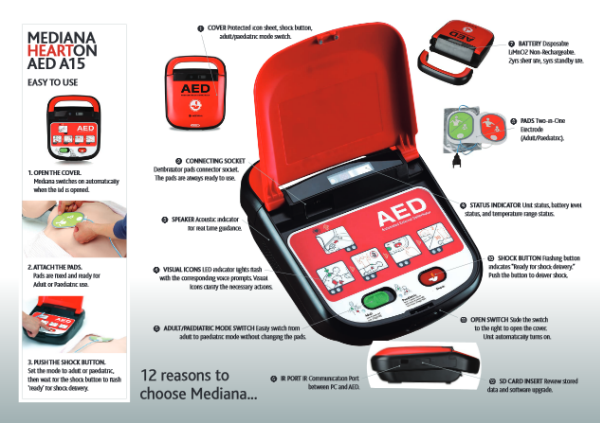Mediana
AED Mediana HeartOn A15 Adult and Paediatric Defibrillator
- SKU:
- 2870
- UPC:
- 5060186995014
- MPN:
- 2870
- Weight:
- 4.20 KGS
Description
• Instant switch from Adult to Paediatric
• Automatic switch on when lid opened
• Pads attached, ready for use
• Pads fit both Adults and Paediatrics

Facts:
- Four times as many women die as a result of a heart attack than they do from breast cancer.
- In the UK, twelve people under the age of 35 die every week due to sudden cardiac arrest.
- For every minutes delay, a victim's chance of surviving a sudden cardiac arrest drops by 7-10%.
- 70% of cardiac arrests occur outside of a hospital environment.
- Almost 95% of sudden cardiac arrest victims die before reaching hospital.
- CPR effectively administered immediately after sudden cardiac arrest, can double a victim's chance of survival.
- Seven out of ten cardiac arrests occur outside of hospital. Currently in the UK, only 2-3% of these people survive.
- Around 270,000 people suffer a heart attack in the UK each year. Of these, up to a third will die before reaching hospital.
- The Department of Health has a target of placing 3,000 new defibrillators in public places in England.
- Explorer, Sir Ranulph Fiennes, is alive today largely thanks to a defibrillator located at Bristol airport.
- Passive smoking increases the risk of developing coronary heart disease by up to 30%.
- Early defibrillation can triple a victims chance of survival.
PRODUCT SPECIFICATION:
DEFIBRILLATION ELECTRIC SHOCK
Waveform:
Biphasic Truncated Exponential (BTE)
waveform (Impedance compensation)
Energy:
Adult: 185 to 200J (±5%)
Paediatric: 45 to 50J (±5%)
Operating Mode: Semi-Auto
ECG
Lead: II (RA,LL)
Patient Impedance: 25 to 175ohm
Detection
V/F more than 200μV
V/T more than 160 per min
INDICATION
CONTROLS
Standard:
Open (power) switch, shock button,
Adult/Paediatric mode switch
INDICATORS
Visible: ICON Indicator, Status LCD (unit status, battery status, temperature status), LED (Adult/Paediatric mode switch LED)
Audible: Speaker (voice prompt), Beep (CPR indication)
PHYSICAL
Dimensions: 294H x 240W x 95mmD
Weight: Approx. 2.65kg (including battery, excluding pads)
SELF TEST
Cycle:
Every 24 hours, 1 week, 1 month
Power on self test, battery insertion self test
Test Result: Status LCD displays ‘O’ / ‘X’
DATA BACKUP AND COMMUNICATION
Standard SD card, IR communication port
ACCESSORY SPECIFICATION
Standby Life: 2 years from date of manufacture
Electrodes: Disposable pads
Placement:
Adult: Anterior-lateral
Paediatric: Anterior-posterior
Minimum active gel area: 80cm2 +/-5%
Cable Length: Approx. 1.8m
Environmental Conditions
Temperature:
Operation: 0 to 43°C (32 to 109.4°F)
Storage: 0 to 43°C (32 to 109.4°F)
Relative Humidity: 5 to 95% RH (non-condensing)
BATTERY
Type: LiMnO2, disposable, long-life primary cell
Voltage/Capacity: 15V, 4200 mAh
Shelf Life: 2 years from date of manufacture (in the original packaging)
Standby Life: 5 years from date of manufacture (inserted in the AED)
Discharge: A minimum of 200 shocks (except the CPR period between the defibrillation therapy) or 10 hours of operating time at 20°C
Environmental Conditions
Temperature:
Operation: 0 to 43°C (32 to 109.4°F)
Storage: 0 to 43°C (32 to 109.4°F)
Relative Humidity: 5 to 95% RH (non-condensing)
Information correct at time of going to press. Subject to change without notice.
Further information about Defibrillators
What is a defibrillator? It can be the difference in saving a life
How does a defibrillator work?
Top Tips for Buying a Defibrillator
Advice for purchasing defibrillators for schools
Defibrillator FAQs
All the defibrillators and AED's we suply are easy to use, self test and whilst users can be safe in the knowledge they cannot get shocked in error by touching the patient during defibrillation.











